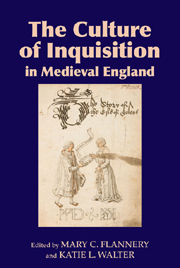Book contents
- Frontmatter
- Contents
- Illustrations
- List of Contributors
- Acknowledgements
- Abbreviations
- Introduction: Imagining Inquisition
- 1 Inquisition, Public Fame and Confession: General Rules and English Practice
- 2 The Imperatives of Denunciatio: Disclosing Others' Sins to Disciplinary Authorities
- 3 English Provincial Constitutions and Inquisition into Lollardy
- 4 The Contest over the Public Imagination of Inquisition, 1380–1430
- 5 ‘Vttirli Onknowe’? Modes of Inquiry and the Dynamics of Interiority in Vernacular Literature
- 6 From Defacement to Restoration: Inquisition, Confession and Thomas Usk's Appeal and Testament of Love
- 7 Confession, Inquisition and Exemplarity in The Erle of Tolous and Other Middle English Romances
- 8 Heresy Inquisition and Authorship, 1400–1560
- 9 Imitating Inquisition: Dialectical Bias in Protestant Prison Writings
- 10 Response Essay: Chaucer's Inquisition
- Bibliography
- Index
3 - English Provincial Constitutions and Inquisition into Lollardy
Published online by Cambridge University Press: 05 April 2013
- Frontmatter
- Contents
- Illustrations
- List of Contributors
- Acknowledgements
- Abbreviations
- Introduction: Imagining Inquisition
- 1 Inquisition, Public Fame and Confession: General Rules and English Practice
- 2 The Imperatives of Denunciatio: Disclosing Others' Sins to Disciplinary Authorities
- 3 English Provincial Constitutions and Inquisition into Lollardy
- 4 The Contest over the Public Imagination of Inquisition, 1380–1430
- 5 ‘Vttirli Onknowe’? Modes of Inquiry and the Dynamics of Interiority in Vernacular Literature
- 6 From Defacement to Restoration: Inquisition, Confession and Thomas Usk's Appeal and Testament of Love
- 7 Confession, Inquisition and Exemplarity in The Erle of Tolous and Other Middle English Romances
- 8 Heresy Inquisition and Authorship, 1400–1560
- 9 Imitating Inquisition: Dialectical Bias in Protestant Prison Writings
- 10 Response Essay: Chaucer's Inquisition
- Bibliography
- Index
Summary
It is now accepted that the moment when the English church first faced popular heresy was a moment of cultural transformation, not least in the sphere of law. A new problem called for new methods, and perhaps a new way of thinking. Between 1382 and 1428 a distinctively English anti-heresy law emerged, and aspects of this have been well studied by recent historians.1 Historians of Wycliffism and lollardy have often in particular attributed great significance to Archbishop Thomas Arundel's constitutions, drafted in 1407 and promulgated in 1409, as a major step in the legal response to heresy, and literary scholars, too, have seen these constitutions as a watershed. There is much debate about their impact on the production of theological and pastoral texts in the vernacular, with scholars giving varying weight to Arundel's legislation in shaping a new cultural world.2 The 1409 constitutions were, however, just one part of the legal response to heresy and, furthermore, they sat within a long tradition of provincial ecclesiastical legislation. This tradition had its roots in the late twelfth century, and gained pace with English responses to the Fourth Lateran Council of 1215, most notably at the Council of Oxford in 1222.
- Type
- Chapter
- Information
- The Culture of Inquisition in Medieval England , pp. 45 - 59Publisher: Boydell & BrewerPrint publication year: 2013



